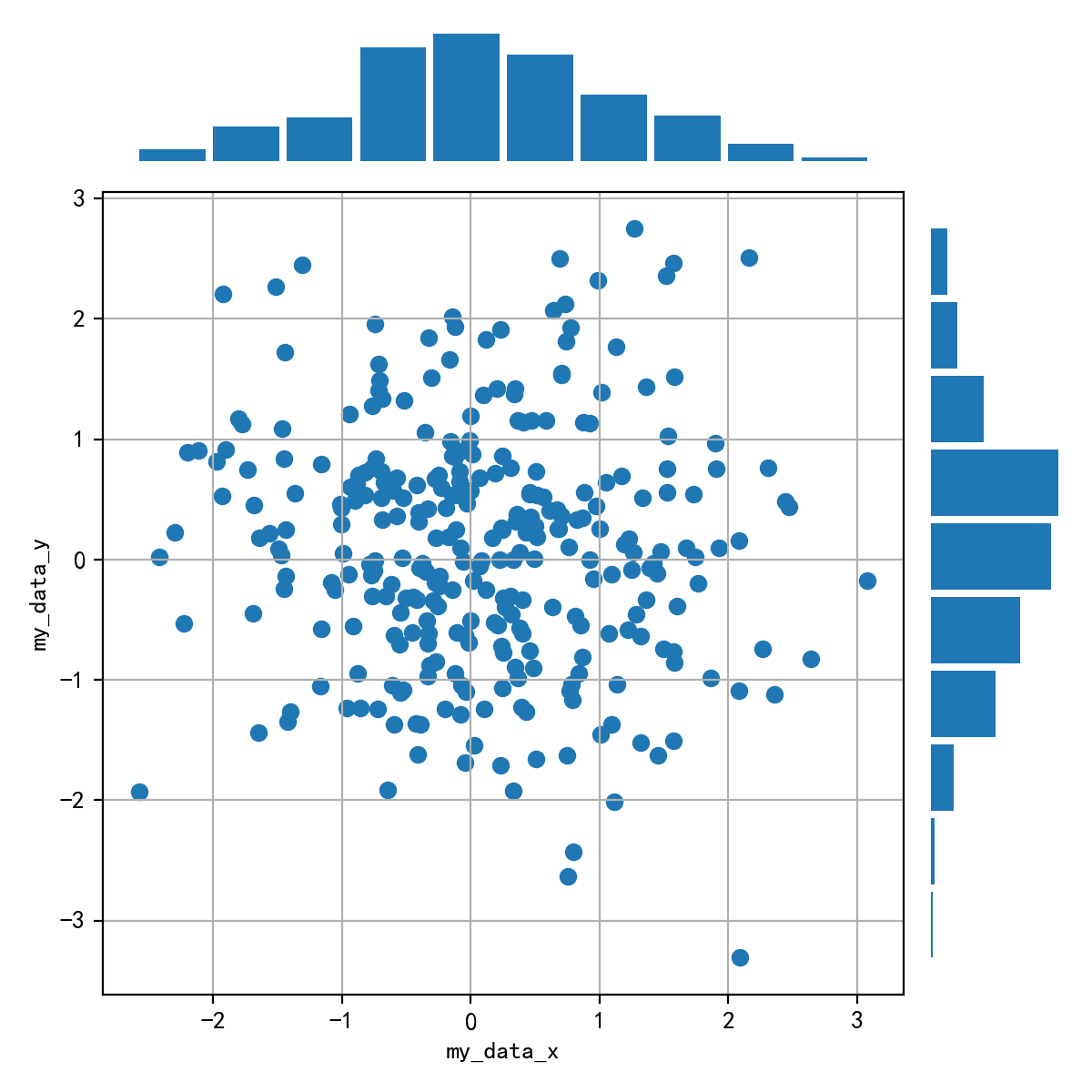文章目录
第三回:布局格式定方圆
import numpy as np
import pandas as pd
import matplotlib.pyplot as plt
plt.rcParams['font.sans-serif'] = ['SimHei'] #用来正常显示中文标签
plt.rcParams['axes.unicode_minus'] = False #用来正常显示负号
一、子图
1. 使用 plt.subplots 绘制均匀状态下的子图
返回元素分别是画布和子图构成的列表,第一个数字为行,第二个为列
figsize 参数可以指定整个画布的大小
sharex 和 sharey 分别表示是否共享横轴和纵轴刻度
tight_layout 函数可以调整子图的相对大小使字符不会重叠
#您可以使用suptitle关键字为主要标题(y)指定y位置。
fig, axs = plt.subplots(2, 5, figsize=(10, 4), sharex=True, sharey=True)
fig.suptitle('样例1', size=20,y=1.1)
for i in range(2):
for j in range(5):
axs[i][j].scatter(np.random.randn(10), np.random.randn(10))
axs[i][j].set_title('第%d行,第%d列'%(i+1,j+1))
axs[i][j].set_xlim(-5,5)
axs[i][j].set_ylim(-5,5)
if i==1: axs[i][j].set_xlabel('横坐标')
if j==0: axs[i][j].set_ylabel('纵坐标')
fig.tight_layout()

除了常规的直角坐标系,也可以通过projection方法创建极坐标系下的图表:
N = 150
r = 2 * np.random.rand(N)
theta = 2 * np.pi * np.random.rand(N)
area = 200 * r**2
colors = theta
plt.subplot(projection='polar')
plt.scatter(theta, r, c=colors, s=area, cmap='hsv', alpha=0.75)
plt.show()

2. 使用 GridSpec 绘制非均匀子图
所谓非均匀包含两层含义,第一是指图的比例大小不同但没有跨行或跨列,第二是指图为跨列或跨行状态
利用 add_gridspec 可以指定相对宽度比例 width_ratios 和相对高度比例参数 height_ratios
fig = plt.figure(figsize=(10, 4))
spec = fig.add_gridspec(nrows=2, ncols=5, width_ratios=[1,2,3,4,5], height_ratios=[1,3])
fig.suptitle('样例2', size=20,y = 1.05)
for i in range(2):
for j in range(5):
ax = fig.add_subplot(spec[i, j])
ax.scatter(np.random.randn(10), np.random.randn(10))
ax.set_title('第%d行,第%d列'%(i+1,j+1))
if i==1: ax.set_xlabel('横坐标')
if j==0: ax.set_ylabel('纵坐标')
fig.tight_layout()
plt.show()

在上面的例子中出现了 spec[i, j] 的用法,事实上通过切片就可以实现子图的合并而达到跨图的功能
fig = plt.figure(figsize=(10, 4))
spec = fig.add_gridspec(nrows=2, ncols=6, width_ratios=[2,2.5,3,1,1.5,2], height_ratios=[1,2])
fig.suptitle('样例3', size=20,y=1.05)
# sub1
ax = fig.add_subplot(spec[0, :3])
ax.scatter(np.random.randn(10), np.random.randn(10))
# sub2
ax = fig.add_subplot(spec[0, 3:5])
ax.scatter(np.random.randn(10), np.random.randn(10))
# sub3
ax = fig.add_subplot(spec[:, 5])
ax.scatter(np.random.randn(10), np.random.randn(10))
# sub4
ax = fig.add_subplot(spec[1, 0])
ax.scatter(np.random.randn(10), np.random.randn(10))
# sub5
ax = fig.add_subplot(spec[1, 1:5])
ax.scatter(np.random.randn(10), np.random.randn(10))
fig.tight_layout()

二、子图上的方法
在 ax 对象上定义了和 plt 类似的图形绘制函数,常用的有: plot, hist, scatter, bar, barh, pie
%matplotlib inline
fig, ax = plt.subplots(figsize=(4,3))
ax.plot([1,2],[2,1])
plt.show()

fig, ax = plt.subplots(figsize=(4,3))
ax.hist(np.random.randn(1000))
plt.show()

fig, axs = plt.subplots(1, 2, figsize=(10, 4))
fig.suptitle('大标题', size=20,y = 1.05)
for j in range(2):
axs[j].plot(list('abcd'), [10**i for i in range(4)])
if j==0:
axs[j].set_yscale('log')
axs[j].set_title('子标题1')
axs[j].set_ylabel('对数坐标')
else:
axs[j].set_title('子标题1')
axs[j].set_ylabel('普通坐标')
fig.tight_layout()

与一般的 plt 方法类似, legend, annotate, arrow, text 对象也可以进行相应的绘制
matplotlib.pyplot.arrow(x, y, dx, dy, **kwargs)
x, y:箭头基准的x和y坐标。
dx, dy:箭头沿x和y方向的长度。
fig, ax = plt.subplots()
ax.arrow(0, 0, 0.8, 0.8, head_width=0.03, head_length=0.05, facecolor='red', edgecolor='blue')
ax.text(x=0, y=0,s='这是一段文字', fontsize=16, rotation=70, rotation_mode='anchor', color='green')
ax.annotate('这是中点', xy=(0.5, 0.5), xytext=(0.8, 0.2), arrowprops=dict(facecolor='yellow', edgecolor='black'), fontsize=16)
plt.show()

fig, ax = plt.subplots()
ax.plot([1,2],[2,1],label="line1")
ax.plot([1,1],[1,2],label="line1")
ax.legend(loc=1)

三、作业
1. 墨尔本1981年至1990年的每月温度情况
ex1 = pd.read_csv('data/layout_ex1.csv')
ex1.head()

- 请利用数据,画出如下的图:

ex1

ex = pd.DataFrame(ex1.loc[0:12,'Temperature']).reset_index()
ex

for i in range(12,120,12):
ex = pd.merge(ex,pd.DataFrame(ex1.loc[i:i+12,'Temperature']).reset_index(drop=True),left_index=True,right_index=True,)
ex = ex.drop(['index'],axis = 1)
ex

ex.columns = ['1981','1982','1983','1984','1985','1986','1987','1988','1989','1990']
ex

fig,ax = plt.subplots(2,5,figsize = (18,5),sharex=True, sharey=True)
fig.suptitle('墨尔本1981年至1990年月温度曲线',size = 25,y = 1.1)
for j in range(5):
ax[0][j].plot(range(1,13),ex.iloc[:,j],'*-')
# ax[0][j].set_xlim(0,13)
# ax[0][j].set_xticks(range(0,13,1))
# ax[0][j].set_ylim(3,20)
# ax[0][j].set_yticks(range(5,20,5))
ax[0][j].set_title(ex.columns[j]+'年')
ax[0][0].set_ylabel('气温')
for j in range(5):
ax[1][j].plot(range(1,13),ex.iloc[:,j+5],'*-')
ax[1][j].set_xlim(0.5,12.5)
ax[1][j].set_xticks(range(1,13,1))
ax[1][j].set_ylim(4,18.5)
ax[1][j].set_yticks(range(5,20,5))
ax[1][j].set_title(ex.columns[j+5]+'年')
ax[1][0].set_ylabel('气温')
fig.tight_layout()
plt.show()

2. 画出数据的散点图和边际分布
- 用
np.random.randn(2, 150)生成一组二维数据,使用两种非均匀子图的分割方法,做出该数据对应的散点图和边际分布图

import numpy as np
import matplotlib.pyplot as plt
rng = np.random.RandomState(0)
x = rng.randn(2,150)
fig,ax = plt.subplots(figsize = (6,6))
ax.scatter(x[0],x[1],c = 'b')
ax.set_xlabel('my_data_x')
ax.set_ylabel('my_data_y')
ax.set_xlim(-2.8,3.5)
ax.set_ylim(-3.5,3.1)
ax.grid()
plt.show()























 被折叠的 条评论
为什么被折叠?
被折叠的 条评论
为什么被折叠?








